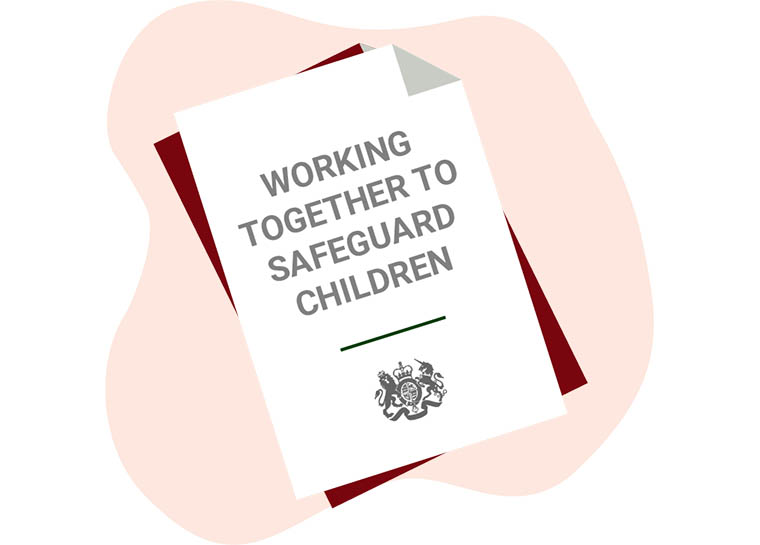
Child Safeguarding Practice Reviews

Introduction
Under Working Together 2018, safeguarding partners are required to promptly undertake a rapid review on all notified serious incidents. Rapid reviews should assemble the facts of the case as quickly as possible in order to establish whether there is any immediate action needed to ensure a child’s safety and the potential for practice learning. The rapid review should conclude with a decision about whether or not a local child safeguarding practice review should be commissioned using the criteria set out in Working Together 2018.
Under Working Together 2018, the criteria for local child safeguarding practice reviews offers greater flexibility for partners to consider how learning is best generated within a new safeguarding arrangement.
The criteria and guidance when deciding whether it is appropriate to undertake a national review of a case, or cases, are set out in Working Together 2018, and these are commissionned by the child safeguarding practice review panel.
What they are
Working Together 2018 sets out that safeguarding partners should have regard to the Child Safeguarding Practice Review Panel's Practice guidance for responding to serious child safeguarding incidents. The national Panel operates under the Child Safeguarding Practice Review and Relevant Agency (England) Regulations 2018.
Serious child safeguarding cases are those in which:
- Abuse or neglect of a child is known or suspected; and
- The child has died or been seriously harmed.
Serious harm includes (but is not limited to) serious and/or long-term impairment of a child’s mental health or intellectual, emotional, social or behavioural development. It should also cover impairment of physical health. This is not an exhaustive list. When making decisions, judgment should be exercised in cases where impairment is likely to be long-term, even if this is not immediately certain. Even if a child recovers, including from a one-off incident, serious harm may still have occurred.
Rapid Reviews
Safeguarding partners are required to promptly undertake a rapid review on all notified serious incident, and if there is more learning to be gained, a LCSPR should be completed. There are no other types of reviews needed or allowed within Working Together. Rapid reviews should assemble the facts of the case as quickly as possible in order to establish whether there is any immediate action needed to ensure a child’s safety and the potential for practice learning. It should be completed within 15 days and include a decision about whether or not a local child safeguarding practice review should be commissioned using the criteria set out in Working Together 2018.
Meeting the criteria does not mean that safeguarding partners must automatically carry out a LCSPR. It is for them to determine whether a review is appropriate, taking into account that the overall purpose of a review is to identify improvements to practice. On receipt of the information from the rapid review, the Panel must decide whether it is appropriate to commission a national review of a case or cases.
Local Child Safeguarding Practice Reviews (LCSPRs) should contain:
- A brief overview of what happened and the key circumstances, background and context of the case. This should be concise but sufficient to understand the context for the learning and recommendations;
- A summary of why relevant decisions by professionals were taken;
- A critique of how agencies worked together and any shortcomings in this;
- Whether any shortcomings identified are features of practice in general;
- What would need to be done differently to prevent harm occurring to a child in similar circumstances; and
- What needs to happen to ensure that agencies learn from this case.
A LCSPR is not an SCR by any other name, and should focus on identifying the areas that need further exploration and a methodology that is most likely to get at the issue in the most timely fashion. It should:
- Build on the work already done in the rapid review, rather than repeat it;
- Consider from the start how the learning gained can be best disseminated across the local arrangements and systems in order to achieve the biggest impact to improve practice;
- Independent views and challenges should be evident within the review, which is different from being independently authored and independent contributions can be from within the local networks;
- Reviews should be finalised within six months, and capture the views of service leaders, frontline practitioner, and the family;
- The final product should be foccused on the issues that have been looked at and the learning that has been identified, and it should then be published for the learning to be available locally and nationally.
Child Safeguarding Practice Review Webinar
With footage taken from the independent national Child Safeguarding Practice Review Panel's first webinar on 4th August 2020, Panel Member Mark Gurrey presents on conducting Local Child Safeguarding Practice Reviews.
Why they are important
The purpose of local and national child safeguarding practice reviews is to bring about changes that will lead to an improved practice system for children and families and a reduction in child abuse and neglect. The lived experience of children and families plays a crucial role in understanding how the safeguarding system can be improved.
It is recognised that because of the nature of maltreatment, children may die or be seriously harmed even when practice is exemplary, and often despite the good work that is being done by practitioners. There is however always room for learning and improvement, and that there are situations where errors or failings by individuals, or within the system itself which may contribute to or compound the harm suffered by victims of maltreatment.
Effective child safeguarding systems relies on practitioners within it feeling confident about their skills and expertise. Equally, no system and no practitioner can be perfect and there needs to be sufficient embedded humility to ensure there is the capacity and capability for learning and improvement.
Local Child Safeguarding Practice Reviews (LSCPRs) should seek to understand both why mistakes were made and, critically, comprehend whether mistakes made on one case frequently happen elsewhere and understand why. This is evidence of system failure.The overall purpose of the child safeguarding practice review arrangements is to explore how practice can be improved more generally through changes to the system as a whole.
It is through this kind of extended analysis that everyone will understand whether or not a systemic change is required, either at a local or national level. Without it, there is the risk of making unnecessary systemic changes or not addressing the root causes of problems. Holding organisations and their leaders to account for the quality of services, and individuals to account for not meeting professional standards are essential pre-requisites for public confidence in the national safeguarding system.Regulatory bodies for the professions hold this key role. Reviews are not designed for this purpose and will not be used in this way. Where reviews identify any actual or potential errors or violations, they should ensure that proper lines of accountability are followed to ensure that those responsible are held to account.
Key findings
The Annual Report of the Child Safeguarding Practice Review Panel sets out the key findings from the review of serious child safeguarding notifications, rapid review minutes and submitted Local Child Safeguarding Practice Reviews (LSCPR). Since the Panel first met in July 2018:
- 473 serious child safeguarding notifications have been received, out of those 198 were in relation to child deaths. 189 related to serious harm, and a further 86 notified us of other issues;
- The first national review ‘It was hard to escape: Safeguarding children at risk from criminal exploitation’ identifies what might be done differently by practitioners to improve approaches to protecting children who find themselves threatened with violence and serious harm by criminal gangs. It found that: known risk factors around vulnerability don’t always act as predictors, Moving children away from the local area isn’t an effective long-term solution to protect them from the reach of criminal gangs, exclusion from mainstream school can escalate the risk of manipulation by criminal networks, relationship based practice and making use of the reachable moment, such as arrests, school exclusion and physical injury, is critical for this group of children;
- The second national review Safeguarding children at risk from sudden expected infant death has recently published and looked into detail at 12 of the 40 cases where babies have died as a result of cosleeping, and further research will be undertaken into this area. The proposed prevent and protect practice model offers a framework for local safeguarding partners to develop their services and support their front-line practitioners.
The third national review will be into Non-Accidental Injuries to babies under 1 year in response to the key findings about non accidental injuries to babies under 1 year:
- 27% of serious incidents notified, which all involved a rapid review. involved the non-accidental injury of a baby under 12 months old;
- Out of 144 rapid reviews 30 reported babies had died and 114 babies survived. It was, however. often the case that those who survived did so not because the serious incident was necessarily less violent, but because of the sophistication and speed of medical intervention;
- Most often the perpetrators were parents or their partners, other family members or carers. Whilst some families had no involvement with the police or children’s social care, other families were well known;
- 16 rapid reviews reported babies who were subject to a child protection plan at the time they were seriously harmed or died. Perpetrators were often very young parents with minimal social support. Disturbingly, a small number of perpetrators had been previously convicted of serious violence or had their previous children removed because of physical abuse.
The review will focus strongly on the motivation and behaviours of male perpetrators, and it is possible that further reviews will be undertaken into this area.
How the multi-agency process works
The process flowchart provides an overview of the various stages of managing a serious child safeguarding incident to the point of the publication of a Local Child Safeguarding Practice Review when the criteria has been met, and includes the statutory timescales under Working Together 2018.
The legal framework for the child safeguarding system in England includes:
Part 3 - 'What happened next' -the child safeguarding incident process
How to access the learning
The Child Safeguarding Practice Review Panel publish data and key findings annually through its Annual Reports (2018-2019 Annual Report; 2020 Annual Report), and issues updates regularly through its online newsletter. To sign up to receive the newsletter click here.
The most recent Triennial Analysis of SCRs can be accessed here.
To access the Learning from SCR e-learning course click here.
Useful Resources
The NSPCC case review repository holds over 1500 published Serious Case Reviews and Child Safeguarding Practice reviews, and provides an abstract for each review with the key learning and recommendations, and can be accessed here. Select "media type" to find "case review" in the drop down menu.
NSPCC library services provide Learning from Case Review briefings which covere key risk factors, and practice improvement recommendations and can be accessed here.
Research in Practice provide a free resource for learning about Serious Case Reviews, and can be accessed here.
